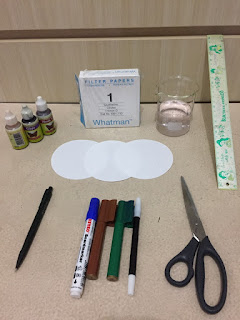There were 2 choices of how I could set up the experiment in my chemistry book, by using either a circular filter paper or just using a strip of it. I decided to use the circular one, because I have that filter paper. Cutting just a strip out of it would be a waste. It's also easier to set up for me.
Materials:
- Beaker/see-through glass
- Filter paper
- Food Colours (the chemical I want to experiment with)
- Markers (the chemical I want to experiment with)
- Ruler
- Pencil
- Scissors
First, I filled the beaker with water (around 250 ml), then dotted the middle of the filter paper with purple food colour. I then cut a strip of the filter paper, 1 cm wide, from the edge of the paper to the centre. Unfortunately, though, my dot was too big, so I couldn't use it. The water won't be able to separate the colours well if it's too big; I need a bigger filter paper for the colours to separate.
So I repeated the steps above, except with a smaller dot. I fold the strip of paper down in the middle and put the filter paper on top of the beaker, making sure that the end of the strip of paper touches the water. The water will soak the paper, and will move up the paper. When it touches the ink, it will separate the colours as it spreads out on the filter paper.
My food colouring has never been used for years, so some of the food colour around the bottle dropper had dried and became powder-like. Some of the powder fell on the strip, and when they got the water, they spread out as pink. You can see it in the picture on the right.
After waiting for around 15 minutes, I started to see a reaction. The first colour that I saw spread out was red, then a little bit of blue. This is how it looks like after I waited a bit longer, around 15 minutes later:
Next, I tried the red food colour:
 |
 |
I made the dot too big, but at least it isn't as big as my first dot at the start of this experiment.
This is how it looked like after 30 minutes:
The only colour I see in this food colour is red. After that I decided to do several colour tests together so that I save time. Otherwise I had to wait around 30 minutes for each test to finish and I wanted to do a lot of colour tests.
This is what happened around 30 minutes later.
A closer look:
 |
 |
 |
 |
I wasn't satisfied with the colour spread of the blue marker, so I decided to change markers. This is the result of my second experiment:
 |
| Satisfying |
The colour spread of the green and brown marker, red and yellow food colouring is true to its respective colour. Green markers produces green colour, brown markers produces brown colour, red food colouring produces red colour and yellow food colouring produces yellow. Whereas the blue board marker produces blue and pink colours. I thought that this was interesting as I didn’t expected pink in a blue marker.I noticed that blue and pink/red appears a lot. I don't exactly know why, but perhaps it's because they're 2 of the 3 primary colours.
Why do different colours rise to different levels? This is because the particles of each colour have different solubility (how well they dissolve in water). Those which are less soluble and doesn't dissolve in water well aren't easily brought along by the water. While those that are more soluble dissolves better in water and are easily brought along the water as it goes up the paper.
It was pretty fun making this experiment, as I could see all the different colours that make up some food colours and markers. This experiment was also time-effective. I had to wait quite long for the colours to spread, so while waiting, I could do my other studies while waiting.








No comments:
Post a Comment